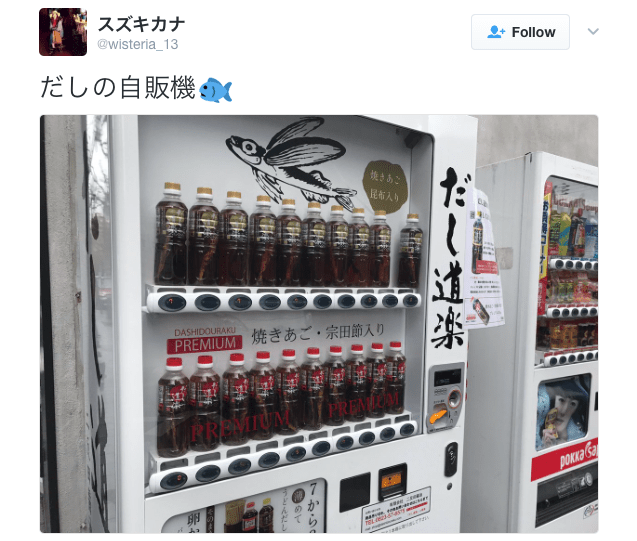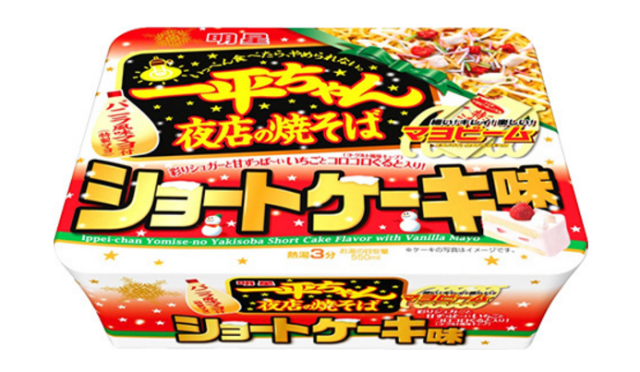Noodles (Page 25)
Now you can get your flying fish soup stock at any time of the day or night in Japan’s capital.
Ramen and green tea are two of the best things to make if you’ve got a pot of hot water, and now you can have both at once.
Uses bear meat sourced from Kyoto and Aomori, said to have more refined taste than foreign varieties.
Two of the biggest names in ramen team up for this American-inspired instant noodle flavor.
I can say fairly certainly that this is the greatest painting of instant deep-fried vegetables ever made.
Put together by the XV development team, this is being billed by its producers as the first-ever official mashup TV commercial in the history of Final Fantasy.
Now there are two Michelin-starred ramen restaurants in the capital, and we lined up to try the signature dish from the latest award-winning eatery.
The company famous for instant noodles is now releasing a limited number of their fresh noodles to lucky customers.



















 7-Eleven Japan’s ramen-cooking robot whipped us up a bowl of noodles【Taste test】
7-Eleven Japan’s ramen-cooking robot whipped us up a bowl of noodles【Taste test】 7 great places to see Mt. Fuji from without having to climb it
7 great places to see Mt. Fuji from without having to climb it Mr. Sato accosts award-winning actor Hideaki Ito【Interview】
Mr. Sato accosts award-winning actor Hideaki Ito【Interview】 Cyberpunk anime meets traditional culture in Ghost in the Shell gold leaf Japanese changing screens
Cyberpunk anime meets traditional culture in Ghost in the Shell gold leaf Japanese changing screens This is possibly the coziest train in all Japan thanks to onboard hot spring footbaths【Pics】
This is possibly the coziest train in all Japan thanks to onboard hot spring footbaths【Pics】 The humane (and adorable) way to make a flat hamster 【Video】
The humane (and adorable) way to make a flat hamster 【Video】 To celebrate 7-Eleven Day, here are seven 7-Eleven Japan items that need more love
To celebrate 7-Eleven Day, here are seven 7-Eleven Japan items that need more love Tokyo train stations giving out awesome giant Pokémon cards, but you’ll want to hurry
Tokyo train stations giving out awesome giant Pokémon cards, but you’ll want to hurry Final Fantasy furniture, Monster Hunter pieces too, coming from Japanese houseware company
Final Fantasy furniture, Monster Hunter pieces too, coming from Japanese houseware company Lacquerware supplier to emperor of Japan and Pokémon team up for new tableware
Lacquerware supplier to emperor of Japan and Pokémon team up for new tableware Disillusionment at Tsukiji’s tourist-target prices led us to a great ramen restaurant in Tokyo
Disillusionment at Tsukiji’s tourist-target prices led us to a great ramen restaurant in Tokyo Japan may add Japanese language proficiency, lifestyle classes to permanent foreign resident requirements
Japan may add Japanese language proficiency, lifestyle classes to permanent foreign resident requirements Starbucks Japan releases new zodiac chilled cup drink for 2026
Starbucks Japan releases new zodiac chilled cup drink for 2026 Japan’s otoshidama tradition of giving kids money at New Year’s gets a social welfare upgrade
Japan’s otoshidama tradition of giving kids money at New Year’s gets a social welfare upgrade Hello Kitty Choco Egg figures are an adorable trip through three periods of Japanese pop culture【Pics】
Hello Kitty Choco Egg figures are an adorable trip through three periods of Japanese pop culture【Pics】 7-Eleven Japan starts new temporary luggage storage service in over 300 branches
7-Eleven Japan starts new temporary luggage storage service in over 300 branches Can a dirty butthole make you filthy rich in Japan? We’re starting a New Year’s lottery experiment
Can a dirty butthole make you filthy rich in Japan? We’re starting a New Year’s lottery experiment Japan’s human washing machines will go on sale to general public, demos to be held in Tokyo
Japan’s human washing machines will go on sale to general public, demos to be held in Tokyo Starbucks teams up with 166-year-old Kyoto doll maker for Year of the Horse decorations【Photos】
Starbucks teams up with 166-year-old Kyoto doll maker for Year of the Horse decorations【Photos】 Tokyo considering law requiring more trash cans following litter increase in heavily touristed area
Tokyo considering law requiring more trash cans following litter increase in heavily touristed area Tokyo’s Tsukiji sushi neighborhood asks tour groups to stay away for the rest of the month
Tokyo’s Tsukiji sushi neighborhood asks tour groups to stay away for the rest of the month Nintendo’s Kirby now delivering orders at Kura Sushi restaurants, but not in Japan
Nintendo’s Kirby now delivering orders at Kura Sushi restaurants, but not in Japan Tokyo event lets you travel back in time, for free, to celebrate 100 years since Showa era start
Tokyo event lets you travel back in time, for free, to celebrate 100 years since Showa era start Sanrio theme park in Japan announces plans to expand into a Sanrio resort
Sanrio theme park in Japan announces plans to expand into a Sanrio resort Stamina-destroying “Paralysis Noodles” are Tokyo’s newest over-the-top ramen innovation
Stamina-destroying “Paralysis Noodles” are Tokyo’s newest over-the-top ramen innovation Survey asks foreign tourists what bothered them in Japan, more than half gave same answer
Survey asks foreign tourists what bothered them in Japan, more than half gave same answer Japan’s deadliest food claims more victims, but why do people keep eating it for New Year’s?
Japan’s deadliest food claims more victims, but why do people keep eating it for New Year’s? We deeply regret going into this tunnel on our walk in the mountains of Japan
We deeply regret going into this tunnel on our walk in the mountains of Japan Studio Ghibli releases Kodama forest spirits from Princess Mononoke to light up your home
Studio Ghibli releases Kodama forest spirits from Princess Mononoke to light up your home Major Japanese hotel chain says reservations via overseas booking sites may not be valid
Major Japanese hotel chain says reservations via overseas booking sites may not be valid Put sesame oil in your coffee? Japanese maker says it’s the best way to start your day【Taste test】
Put sesame oil in your coffee? Japanese maker says it’s the best way to start your day【Taste test】 The top 10 annoying foreign tourist behaviors on trains, as chosen by Japanese people【Survey】
The top 10 annoying foreign tourist behaviors on trains, as chosen by Japanese people【Survey】 No more using real katana for tourism activities, Japan’s National Police Agency says
No more using real katana for tourism activities, Japan’s National Police Agency says Starbucks Japan reveals new sakura drinkware collection, inspired by evening cherry blossoms
Starbucks Japan reveals new sakura drinkware collection, inspired by evening cherry blossoms The humane (and adorable) way to make a flat hamster 【Video】
The humane (and adorable) way to make a flat hamster 【Video】 To celebrate 7-Eleven Day, here are seven 7-Eleven Japan items that need more love
To celebrate 7-Eleven Day, here are seven 7-Eleven Japan items that need more love Tokyo train stations giving out awesome giant Pokémon cards, but you’ll want to hurry
Tokyo train stations giving out awesome giant Pokémon cards, but you’ll want to hurry Final Fantasy furniture, Monster Hunter pieces too, coming from Japanese houseware company
Final Fantasy furniture, Monster Hunter pieces too, coming from Japanese houseware company Lacquerware supplier to emperor of Japan and Pokémon team up for new tableware
Lacquerware supplier to emperor of Japan and Pokémon team up for new tableware Line up in the hall, open your shirts, show your bras – Real instructions from one Japanese school
Line up in the hall, open your shirts, show your bras – Real instructions from one Japanese school Rumors say Tokyo’s Sensoji Temple sticks you with bad fortunes, so we bought 100 to find out
Rumors say Tokyo’s Sensoji Temple sticks you with bad fortunes, so we bought 100 to find out Starbucks Japan releases new zodiac chilled cup drink for 2026
Starbucks Japan releases new zodiac chilled cup drink for 2026 Competitive karuta manga series Chihayafuru lays all cards on the table with its final chapter
Competitive karuta manga series Chihayafuru lays all cards on the table with its final chapter Princesses, fruits, and blacksmiths: Study reveals the 30 most unusual family names in Japan
Princesses, fruits, and blacksmiths: Study reveals the 30 most unusual family names in Japan What’s the rule for where to put strollers on Japan’s Shinkansen bullet trains?
What’s the rule for where to put strollers on Japan’s Shinkansen bullet trains? Black Thunder chocolate-bar-shaped fishing lures coming next year
Black Thunder chocolate-bar-shaped fishing lures coming next year Final results: Here’s what Seiji’s balding head looks like one year after hair transplant surgery
Final results: Here’s what Seiji’s balding head looks like one year after hair transplant surgery